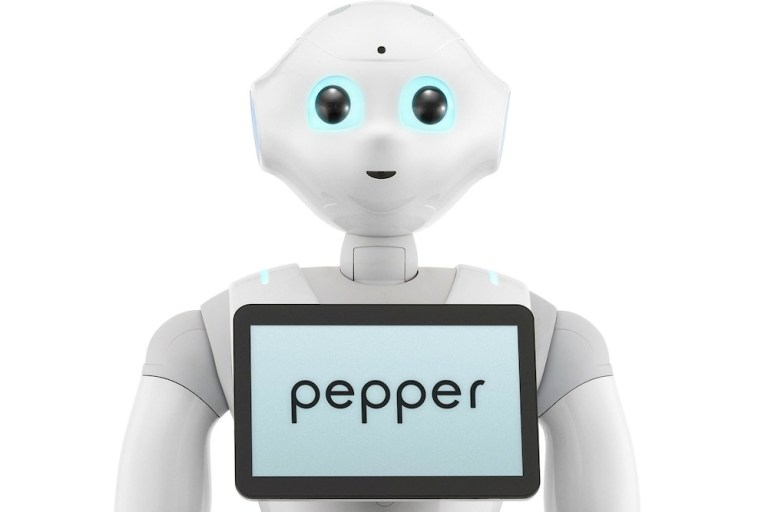Imagine you were traveling on business and you just arrived into town and had an emergency. Your luggage was sent to the wrong city or you were late for a critical meeting and you needed directions to the convention center.
The check-in counter has a dozen guests waiting and the concierge is busy. Well, you may be in luck, because a four-foot robot with an open tablet computer and no waiting line is standing in the corner, and just may be able to come to your assistance. Meet Pepper.
Pepper is an intelligent assistant that costs a bit more than a smart speaker, and can engage you in ways that go beyond ordering pizza or playing your favorite Top 40 tunes on the radio. Pepper is a humanoid robot from SoftBank Robotics that can interact with intelligent conversation and understand – at least to a limited degree – your emotional state of mind.
Retail, Customer Service Focus
Steve Carlin, chief strategy officer at SoftBank Robotics, North America, told PYMNTS CEO Karen Webster that the long-term potential for Pepper is to engage human customers in a setting in the hospitality, retail, banking or automotive industries, in ways that can make people feel comfortable enough to ask those simple questions that they may feel reticent about engaging with a human.
“What was a little surprising was how much more interested people are to start their experience in a retail setting with Pepper than they would with, say, a human staff worker,” said Carlin in an interview with Webster. “We all have experience with someone asking us if we need any help. And our first reaction is ‘no, I’m just looking.’”
Advertisement: Scroll to Continue
Pepper is the result of a joint effort between SoftBank and the French robotics firm Aldebaran, which had previously developed a 58-centimeter robot called NAO, which was widely used in academic and laboratory settings. The robot was used to help teach autistic children in the U.K. and, in other cases, used for customer service by Mizuho Bank for its bank branches in Japan.
Pepper was developed as a robot that would have a presence with people and create an empathetic relationship with technology, Carlin explained.
Pepper was originally designed as an approachable humanoid robot that can engage customers in a way that makes ordinary people, even children in many cases, feel comfortable asking questions, getting directions or handling other tasks that would potentially free up staff at a bank, hotel or retail store to become more productive.
Future Use
Pepper the robot was originally conceived to become a customer service assistant within a retail environment – and while the assistant is capable of human actions like head rotations, emotional interaction and other advanced skills, the industry is still working on natural language processing and other skills that would make it cost-effective to produce such a device for the average family.
Asked about the types of skills included in Pepper’s current range of functions, Carlin said the design of the robot is to perform a certain level of tasks that are complementary to human interaction, but the robot is not currently designed to function independently as a human.
“It’s not going to vacuum the rug or go into another room and grab something for you and bring it back,” Carlin noted.
People of a certain age may recall the iconic 1960s cartoon The Jetsons, which featured Rosie the Robot. She functioned as the family maid, performing everything from laundry to cooking, and interacted with George and the kids like she was one of the family. But the prohibitive cost, as well as the required language processing and machine learning required to interact at that level, are decades away from practical use.
More Than a Smart Speaker
Carlin said that Pepper can engage customers in a proactive way that a mobile device or kiosk cannot, and helps to develop a relationship with consumers. At the same time, customers in many cases have been willing to engage with Pepper in certain situations where they would not approach a human staffer or customer service agent.
“What’s been amazing is to see how quickly people will engage with Pepper and ask the questions they really want to ask,” Carlin noted.
He cautioned that the existing limits of artificial intelligence mean that Pepper cannot have a complete conversation with customers as would a human, noting that AI experts warn such a high level of sophistication in the technology could take another 30 years to accomplish.
However, the information gathered from prior interactions with customers has enabled the company to program the robot’s dialogue flow engine to create what is effectively a chatbot that would be able to engage in conversations related to banking, such as asking about a checking account or credit card.
“It can have a much more meaningful and deep conversation in that specific location with that specific vertical in mind,” Carlin told Webster. “Even though we know that it can’t then turn and tell you which pitcher the Dodgers should trade away next season.”
Like a lot of digital assistants, part of the evolution of Pepper’s ability to interact with customers is that it captures new information based on the questions people ask, which gives the company the ability to tailor the robot’s capabilities toward the particular needs of those customers. Carlin noted, however, that they do not capture personally identifiable information.
For example, a customer walking into HSBC Bank in Manhattan, where Pepper works as a digital assistant, may need to ask where the closest subway station is located.
“Where I’m going next is really important for that shopper, that customer,” said Carlin. “Being able to take it just one step further really solidifies the experience that they have.”
In the hospitality sector, Pepper has proven to be very popular with helping to improve consumer ratings at individual hotel properties. Courtyard by Marriott, for example, saw an 11-point increase in its consumer rating after using Pepper as a guest assistant – and in the hospitality business, a simple one-point increase is considered a major improvement.
Evolving Skills
Asked whether Pepper would ever become a home assistant device, Carlin said it will likely be up to 30 years before this type of technology is found in every home. He noted, however, that the company is open to working with developers who want to create new applications for the robot, but cautioned that the value proposition to use Pepper as a home assistant has to be very strong.
“The experience that you’re going to have as a family in your home needs to be strong; it needs to be a really strong value proposition for this particular sized robot with the relative costs associated with it,” he said. “This is not hundreds of dollars, this is thousands of dollars.”




